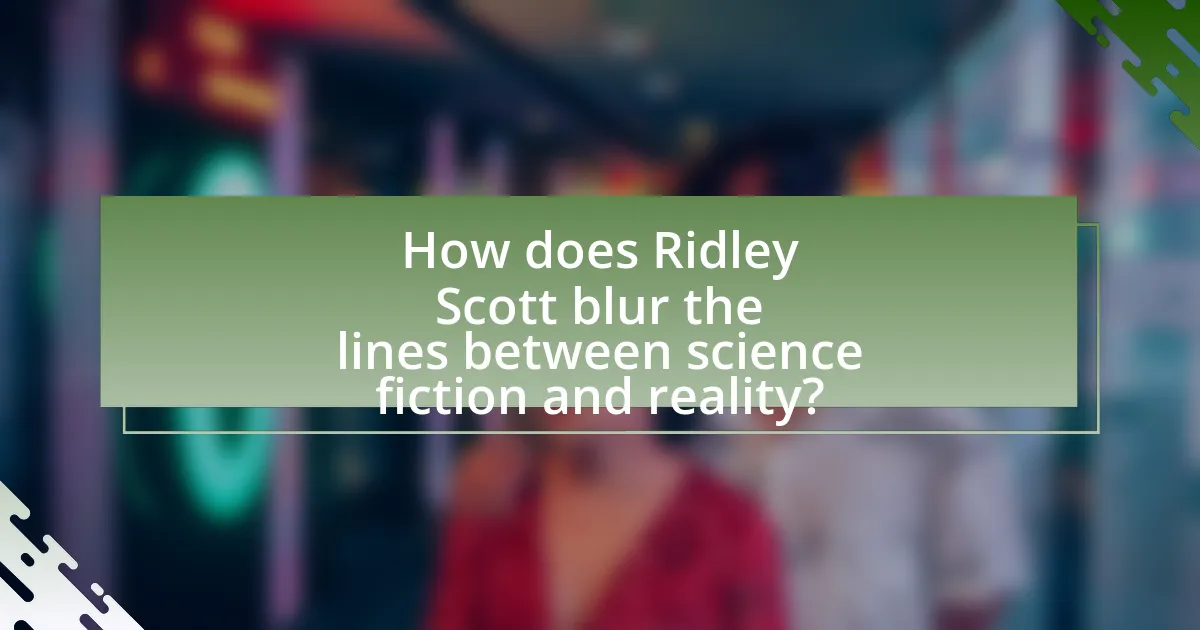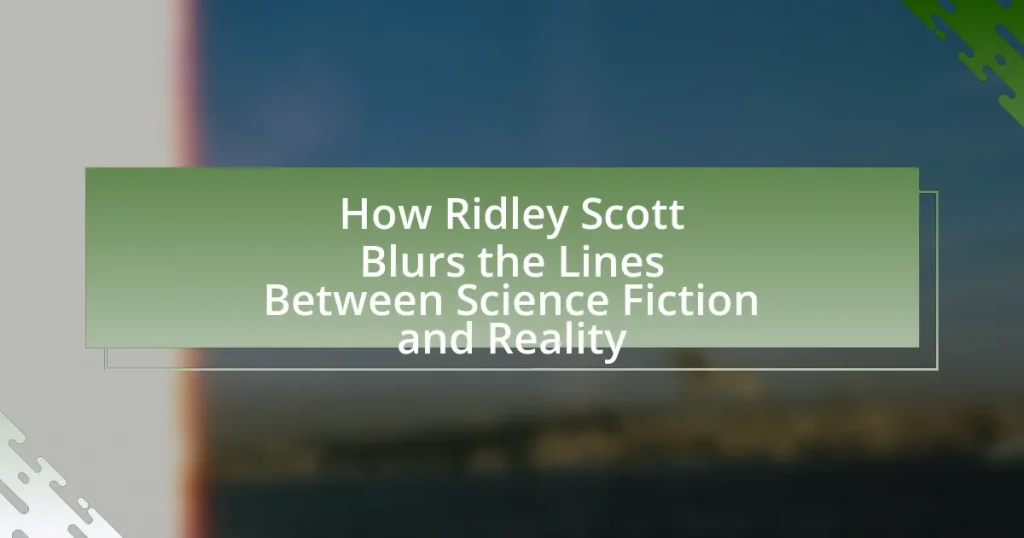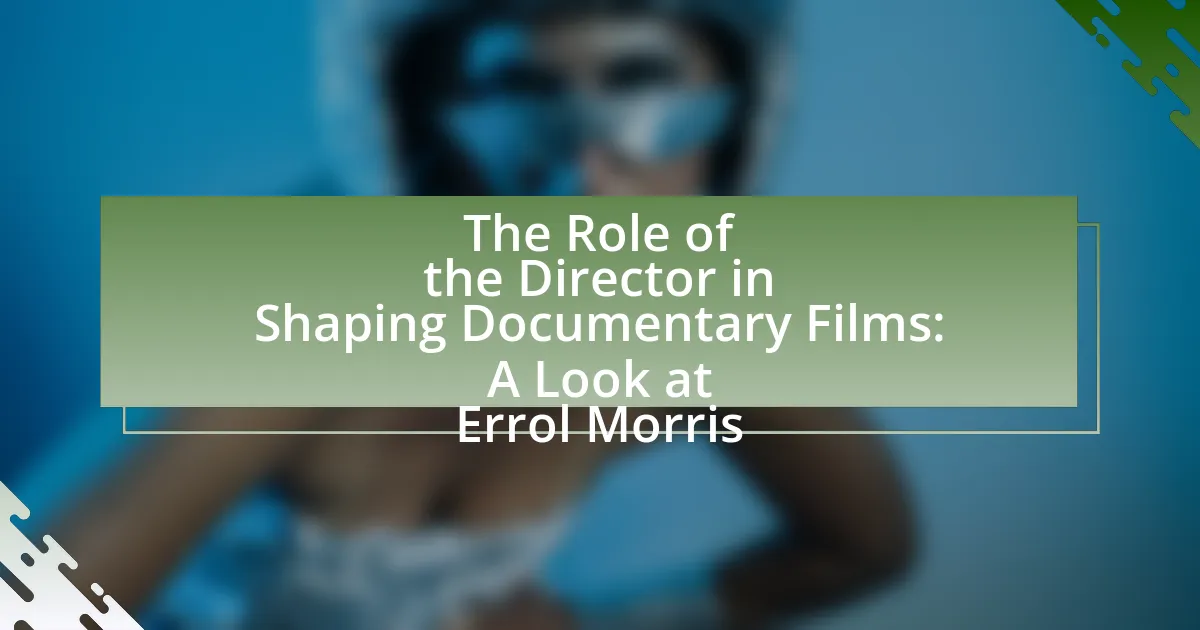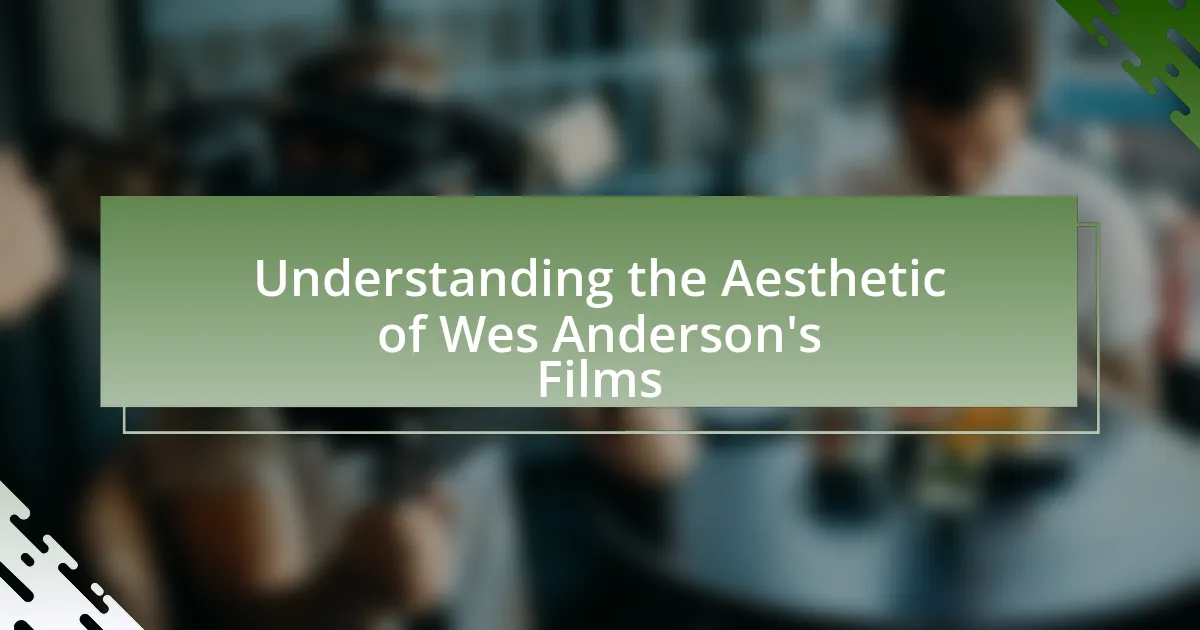Ridley Scott is a prominent filmmaker known for blurring the lines between science fiction and reality in his works. His films, such as “Blade Runner” and “The Martian,” integrate realistic settings, advanced technology, and human emotion, creating immersive narratives that resonate with contemporary societal issues. Scott explores themes of humanity, identity, and the consequences of technology, reflecting ethical dilemmas relevant to modern audiences. His meticulous attention to visual aesthetics and production design enhances the believability of his worlds, while his characters embody complex psychological struggles that challenge traditional science fiction tropes. Through his innovative storytelling, Scott has significantly influenced the science fiction genre, prompting critical discourse on the implications of technological advancements and ethical considerations in society.

How does Ridley Scott blur the lines between science fiction and reality?
Ridley Scott blurs the lines between science fiction and reality by integrating realistic settings, advanced technology, and human emotion into his narratives. His films, such as “Blade Runner” and “The Martian,” utilize detailed world-building and authentic scientific principles to create immersive experiences that resonate with contemporary societal issues. For instance, “Blade Runner” explores themes of identity and humanity through replicants, reflecting real-world discussions on artificial intelligence and ethics. Additionally, “The Martian” employs accurate scientific methods for survival in space, showcasing Scott’s commitment to realism in speculative scenarios. This combination of relatable human experiences and plausible technological advancements effectively merges the realms of science fiction and reality.
What themes does Ridley Scott explore in his science fiction films?
Ridley Scott explores themes of humanity, identity, and the consequences of technology in his science fiction films. In “Blade Runner,” he delves into what it means to be human through the lens of replicants, questioning the nature of consciousness and empathy. “Alien” examines survival and the fear of the unknown, highlighting the dangers of unchecked technological advancement. Additionally, “Prometheus” addresses themes of creation and existential inquiry, as characters confront their origins and the moral implications of their pursuits. These films collectively reflect Scott’s interest in the complex relationship between humanity and its creations, emphasizing the ethical dilemmas posed by scientific progress.
How do these themes reflect contemporary societal issues?
Ridley Scott’s themes in his works reflect contemporary societal issues by exploring the ethical implications of technology and the human condition. For instance, in “Blade Runner,” the portrayal of artificial intelligence raises questions about identity, autonomy, and the moral responsibilities of creators, mirroring current debates on AI ethics and surveillance. Additionally, the dystopian settings often highlight social inequality and environmental degradation, which resonate with ongoing global discussions about climate change and economic disparity. These thematic elements serve as a lens through which audiences can examine and critique the complexities of modern society.
What role does technology play in his storytelling?
Technology serves as a crucial element in Ridley Scott’s storytelling by enhancing visual realism and creating immersive worlds. His use of advanced special effects, CGI, and innovative cinematography techniques allows audiences to experience complex narratives that blend science fiction with reality. For instance, in films like “Blade Runner” and “The Martian,” Scott employs cutting-edge technology to depict futuristic environments and realistic space travel, which not only captivates viewers but also prompts them to reflect on contemporary societal issues. This integration of technology into his storytelling reinforces the thematic depth and emotional resonance of his films, making them both visually stunning and thought-provoking.
In what ways does Ridley Scott utilize visual aesthetics to create realism?
Ridley Scott utilizes visual aesthetics to create realism through meticulous attention to detail, atmospheric lighting, and practical effects. His films often feature authentic set designs and locations that enhance the believability of the narrative, as seen in “Blade Runner,” where the dystopian cityscape is crafted with intricate textures and neon lighting that evoke a tangible world. Additionally, Scott employs naturalistic color palettes and dynamic camera work to immerse viewers in the story, exemplified in “The Martian,” where the use of real Martian landscapes filmed in the desert adds to the film’s authenticity. By combining these elements, Scott effectively blurs the lines between science fiction and reality, making his cinematic worlds feel plausible and relatable.
What techniques does he employ to enhance the believability of his worlds?
Ridley Scott employs techniques such as meticulous world-building, attention to detail, and the integration of real scientific principles to enhance the believability of his worlds. His films often feature realistic set designs and practical effects that create immersive environments, as seen in “Blade Runner,” where the dystopian cityscape feels tangible and lived-in. Additionally, Scott collaborates with experts in various fields, including science and technology, to ensure that the speculative elements of his narratives are grounded in plausible realities, further reinforcing the authenticity of the worlds he creates.
How does production design contribute to the fusion of science fiction and reality?
Production design significantly contributes to the fusion of science fiction and reality by creating immersive environments that blend futuristic elements with recognizable, everyday details. This approach allows audiences to suspend disbelief and engage with the narrative on a deeper level. For instance, Ridley Scott’s use of practical effects, intricate set designs, and authentic materials in films like “Blade Runner” establishes a believable world where advanced technology coexists with human experiences. The meticulous attention to detail in production design, such as the incorporation of real-world architecture and textures, reinforces the plausibility of the science fiction elements, making them relatable and grounded in reality.
How do Ridley Scott’s characters embody the tension between fiction and reality?
Ridley Scott’s characters embody the tension between fiction and reality through their complex motivations and moral dilemmas, often reflecting real-world issues within fantastical settings. For instance, in “Blade Runner,” the replicants grapple with their artificial existence and the quest for identity, mirroring contemporary debates about artificial intelligence and what it means to be human. Similarly, in “The Martian,” Mark Watney’s struggle for survival on Mars highlights human resilience and ingenuity, paralleling real-life challenges in space exploration and environmental sustainability. These narratives intertwine fictional elements with relatable human experiences, effectively blurring the lines between the imagined and the actual.
What psychological complexities do his characters reveal?
Ridley Scott’s characters reveal profound psychological complexities, often reflecting themes of identity, morality, and existential dread. For instance, in “Blade Runner,” the replicants grapple with their artificiality and the quest for a meaningful existence, showcasing their struggle with self-awareness and the desire for autonomy. This complexity is further illustrated through the character of Roy Batty, who embodies the conflict between programmed obedience and the yearning for life experiences, highlighting the tension between creator and creation. Such portrayals underscore the human condition, as they evoke empathy and challenge viewers to confront their own perceptions of humanity and consciousness.
How do character arcs challenge traditional science fiction tropes?
Character arcs challenge traditional science fiction tropes by introducing complex, evolving characters that defy archetypal roles. In many classic science fiction narratives, characters often serve as mere vehicles for technological or philosophical exploration, lacking depth and personal growth. However, films directed by Ridley Scott, such as “Blade Runner” and “Alien,” showcase characters who undergo significant transformations, grappling with moral dilemmas and existential questions. For instance, the character of Rick Deckard in “Blade Runner” evolves from a detached bounty hunter to someone questioning the nature of humanity and his own identity, thereby subverting the trope of the unflinching hero. This shift emphasizes emotional depth and personal stakes, making the narrative more relatable and reflective of real human experiences.
What influences shape Ridley Scott’s approach to science fiction?
Ridley Scott’s approach to science fiction is shaped by a combination of visual artistry, philosophical themes, and real-world technological advancements. His films often reflect a deep exploration of human nature and existential questions, as seen in works like “Blade Runner,” which examines identity and morality in a dystopian future. Additionally, Scott’s background in advertising and visual storytelling influences his meticulous attention to detail and atmospheric world-building, creating immersive environments that resonate with audiences. His incorporation of contemporary issues, such as environmental concerns and corporate ethics, further grounds his science fiction narratives in reality, making them relevant and thought-provoking.
How do historical events inform his narratives?
Historical events significantly inform Ridley Scott’s narratives by providing a rich backdrop that enhances the authenticity and depth of his storytelling. For instance, in films like “Gladiator,” Scott draws on the historical context of the Roman Empire, utilizing real events and figures to create a compelling narrative that resonates with audiences. This approach not only grounds his science fiction elements in reality but also allows viewers to engage with themes of power, betrayal, and morality that are timeless and relevant. By weaving historical accuracy into his narratives, Scott effectively blurs the lines between fiction and reality, making his stories more impactful and thought-provoking.
What specific events have inspired his films?
Ridley Scott’s films have been inspired by specific events such as the technological advancements of the late 20th century, particularly the rise of artificial intelligence and space exploration. For instance, the development of robotics and AI in the 1970s influenced “Blade Runner,” which explores themes of humanity and technology. Additionally, the real-life space missions and the scientific discoveries of the time shaped “The Martian,” reflecting the challenges and possibilities of human survival on Mars. These inspirations are rooted in actual historical and scientific contexts, demonstrating how Scott intertwines fiction with reality.
How does he reinterpret history through a science fiction lens?
Ridley Scott reinterprets history through a science fiction lens by blending historical events with speculative elements to explore themes of humanity and morality. In films like “Blade Runner,” Scott uses a dystopian future to reflect on contemporary societal issues, such as the implications of technology and the nature of existence. His portrayal of historical figures and events often incorporates futuristic settings or advanced technologies, allowing audiences to question the reliability of historical narratives. For instance, in “Gladiator,” while set in ancient Rome, the film’s themes of power and betrayal resonate with modern audiences, illustrating how history can be reimagined to reflect current human experiences. This approach encourages viewers to consider the cyclical nature of history and the impact of human choices across time.
What role do philosophical questions play in his work?
Philosophical questions play a central role in Ridley Scott’s work by challenging viewers to contemplate the nature of humanity, existence, and morality. His films, such as “Blade Runner” and “Prometheus,” explore themes like artificial intelligence, the essence of life, and ethical dilemmas, prompting audiences to reflect on what it means to be human. For instance, “Blade Runner” raises questions about the rights of synthetic beings and the moral implications of their creation, illustrating Scott’s intent to blur the lines between human and machine. This engagement with philosophical inquiry not only enriches the narrative depth of his films but also invites critical discourse on contemporary issues, reinforcing the relevance of his work in both cinematic and philosophical contexts.
How does Scott address existential themes in his films?
Ridley Scott addresses existential themes in his films by exploring the nature of humanity, identity, and the consequences of technological advancement. In “Blade Runner,” for instance, he delves into what it means to be human through the experiences of replicants who seek their own identities and purpose, raising questions about consciousness and morality. Similarly, in “Prometheus,” Scott examines humanity’s origins and the quest for knowledge, highlighting the existential dread associated with discovering one’s place in the universe. These films illustrate the tension between human aspirations and the often harsh realities of existence, reinforcing the notion that technological progress can lead to profound ethical dilemmas and existential crises.
What philosophical influences can be traced in his storytelling?
Ridley Scott’s storytelling is influenced by existentialism and postmodernism. Existential themes are evident in films like “Blade Runner,” where characters grapple with identity and the nature of humanity, reflecting existentialist ideas from philosophers such as Jean-Paul Sartre and Albert Camus. Additionally, postmodern influences manifest in Scott’s use of fragmented narratives and intertextuality, as seen in “The Martian,” which challenges traditional storytelling structures and emphasizes the subjective nature of reality, aligning with postmodern thinkers like Jean-François Lyotard. These philosophical influences shape Scott’s exploration of complex themes, blurring the lines between science fiction and reality.
How does Ridley Scott’s background in advertising impact his filmmaking style?
Ridley Scott’s background in advertising significantly impacts his filmmaking style by emphasizing visual storytelling and meticulous attention to detail. His experience in creating compelling advertisements has honed his ability to craft striking imagery and establish mood through visuals, which is evident in films like “Blade Runner” and “Alien.” Scott’s advertising roots also contribute to his focus on strong, memorable visuals that engage audiences quickly, mirroring the concise and impactful nature of commercials. This approach allows him to blur the lines between science fiction and reality, as he creates immersive worlds that feel both futuristic and relatable, enhancing the viewer’s experience.
What techniques from advertising does he incorporate into his films?
Ridley Scott incorporates techniques from advertising into his films by utilizing strong visual storytelling, emotional appeal, and brand-like character development. His films often feature meticulously crafted visuals that resemble high-quality advertisements, enhancing the viewer’s emotional connection to the narrative. For instance, in “Blade Runner,” the use of neon lighting and urban landscapes creates a visually striking atmosphere that mirrors advertising aesthetics. Additionally, Scott’s focus on character arcs often parallels brand narratives, where characters evolve in ways that resonate with audiences, similar to how brands build loyalty through storytelling. This blending of advertising techniques with cinematic storytelling effectively blurs the lines between fiction and reality, engaging viewers on multiple levels.
How does this background affect audience engagement with his narratives?
Ridley Scott’s background in visual storytelling and his experience in various genres significantly enhance audience engagement with his narratives. His ability to blend science fiction with realistic elements creates immersive worlds that resonate with viewers, making them more invested in the story. For instance, Scott’s meticulous attention to detail in films like “Blade Runner” and “The Martian” showcases his commitment to authenticity, which fosters a deeper emotional connection with the audience. This connection is evidenced by the critical acclaim and box office success of his films, indicating that audiences are drawn to narratives that feel both imaginative and plausible.
What are the critical responses to Ridley Scott’s blending of genres?
Critics have responded to Ridley Scott’s blending of genres with a mix of admiration and skepticism. Many praise his ability to merge science fiction with elements of horror and drama, particularly in films like “Alien” and “Blade Runner,” where the combination creates a unique atmosphere that challenges traditional genre boundaries. For instance, “Alien” is often lauded for its innovative approach to horror within a sci-fi framework, as noted by film scholars who highlight its suspenseful tension and character development. However, some critics argue that this blending can lead to narrative dissonance, where the thematic coherence is compromised, making it difficult for audiences to engage fully with the story. This critique is evident in discussions surrounding “Prometheus,” where the ambitious genre fusion received mixed reviews for its execution. Overall, Ridley Scott’s genre blending elicits diverse critical responses, reflecting both the innovative potential and the challenges of such artistic choices.
How have critics interpreted his approach to science fiction?
Critics have interpreted Ridley Scott’s approach to science fiction as a blend of philosophical inquiry and visual storytelling that challenges the boundaries between reality and speculative futures. His films, such as “Blade Runner” and “Alien,” are often praised for their deep exploration of existential themes, including identity, humanity, and technology’s impact on society. For instance, “Blade Runner” has been noted for its examination of what it means to be human in a world populated by artificial beings, prompting discussions about ethics and consciousness. This thematic depth, combined with Scott’s distinctive visual style, has led critics to view his work as not merely entertainment but as a commentary on contemporary issues, thereby blurring the lines between science fiction and reality.
What common critiques arise regarding his portrayal of reality?
Common critiques regarding Ridley Scott’s portrayal of reality include the tendency to prioritize visual spectacle over narrative coherence. Critics argue that his films often sacrifice character development and logical consistency in favor of stunning imagery and ambitious world-building. For instance, in “Blade Runner,” while the visual aesthetics are groundbreaking, some reviewers note that the plot can feel convoluted and lacks clarity, which detracts from the overall narrative experience. Additionally, Scott’s depiction of futuristic societies sometimes leans towards dystopian clichés, leading to accusations of superficiality in exploring complex themes. These critiques highlight a perceived imbalance between artistic ambition and storytelling effectiveness in his work.
How do audiences perceive the balance between fiction and reality in his films?
Audiences perceive the balance between fiction and reality in Ridley Scott’s films as a nuanced interplay that often challenges their understanding of both realms. Scott’s meticulous attention to detail, combined with his use of realistic settings and advanced technology, creates a sense of authenticity that resonates with viewers. For instance, in “Blade Runner,” the depiction of a dystopian future is grounded in real-world societal issues, prompting audiences to reflect on contemporary themes such as identity and morality. This blending of the fantastical with relatable human experiences allows audiences to engage deeply with the narrative, often blurring their ability to distinguish between the two.
What impact has Ridley Scott had on the science fiction genre?
Ridley Scott has significantly shaped the science fiction genre through his innovative storytelling and visual aesthetics. His film “Blade Runner,” released in 1982, is often credited with establishing the cyberpunk subgenre, influencing countless filmmakers and works in both film and literature. The film’s exploration of artificial intelligence and humanity set a new standard for thematic depth in science fiction. Additionally, Scott’s “Alien,” released in 1979, redefined the horror elements within science fiction, blending suspense with advanced technology and alien life forms, which has inspired a multitude of subsequent films. His ability to create immersive worlds and complex characters has elevated the genre, making it a platform for philosophical and ethical discussions about technology and existence.
How has his work influenced other filmmakers?
Ridley Scott’s work has significantly influenced other filmmakers by setting new standards for visual storytelling and thematic depth in science fiction. His films, particularly “Blade Runner” and “Alien,” introduced innovative techniques in world-building and atmosphere, inspiring directors like Denis Villeneuve and Christopher Nolan to explore complex narratives and rich visual aesthetics. Scott’s use of practical effects combined with atmospheric lighting has encouraged a generation of filmmakers to prioritize immersive environments, as seen in Villeneuve’s “Blade Runner 2049,” which pays homage to Scott’s original vision. Additionally, Scott’s exploration of moral ambiguity and existential themes has prompted filmmakers to delve deeper into character development and philosophical questions, shaping the narrative landscape of modern science fiction cinema.
What legacy does he leave in the realm of science fiction cinema?
Ridley Scott leaves a profound legacy in science fiction cinema through his innovative storytelling and visual aesthetics. His films, such as “Blade Runner” and “Alien,” have set benchmarks for world-building and thematic depth, influencing countless filmmakers and shaping the genre’s evolution. Scott’s ability to blend philosophical questions about humanity with cutting-edge technology and design has redefined audience expectations, making his work a cornerstone of modern science fiction. The visual style and narrative complexity of his films have inspired a generation, establishing a lasting impact on both the genre and the broader cinematic landscape.
What can viewers learn from Ridley Scott’s films about the future of humanity?
Viewers can learn that Ridley Scott’s films often depict a future where humanity grapples with the consequences of technological advancement and moral dilemmas. For instance, in “Blade Runner,” the exploration of artificial intelligence raises questions about identity and what it means to be human, suggesting that future societies may struggle with ethical implications of their creations. Similarly, “Prometheus” delves into themes of creation and existential inquiry, indicating that humanity’s quest for knowledge could lead to unforeseen repercussions. These narratives highlight the potential for both innovation and destruction, emphasizing the need for responsible stewardship of technology and a deeper understanding of our own nature as we advance.
How do his films provoke thought about technological advancements?
Ridley Scott’s films provoke thought about technological advancements by presenting dystopian futures that reflect contemporary societal concerns regarding technology. For instance, in “Blade Runner,” the depiction of replicants raises ethical questions about artificial intelligence and the nature of humanity, prompting viewers to consider the implications of creating sentient beings. Additionally, “The Martian” showcases advanced space technology and human ingenuity, encouraging discussions about the future of space exploration and the role of technology in overcoming challenges. These narratives not only entertain but also serve as cautionary tales, urging audiences to reflect on the trajectory of technological development and its potential consequences.
What lessons can be drawn regarding ethical considerations in science fiction?
Ethical considerations in science fiction often highlight the potential consequences of technological advancements and human actions. For instance, Ridley Scott’s films, such as “Blade Runner,” explore themes of artificial intelligence and the moral implications of creating sentient beings. These narratives prompt audiences to reflect on issues like autonomy, identity, and the responsibilities of creators towards their creations. The ethical dilemmas presented in these stories serve as cautionary tales, emphasizing the need for responsible innovation and the importance of considering the societal impact of scientific progress.




